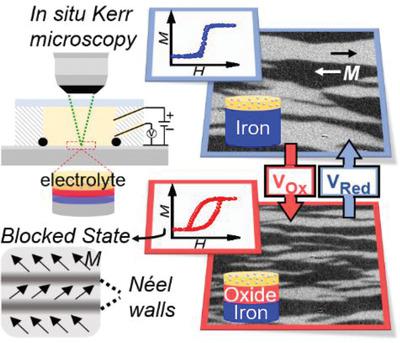当前位置:
X-MOL 学术
›
Adv. Electron. Mater.
›
论文详情
Our official English website, www.x-mol.net, welcomes your
feedback! (Note: you will need to create a separate account there.)
Voltage‐Controlled Deblocking of Magnetization Reversal in Thin Films by Tunable Domain Wall Interactions and Pinning Sites
Advanced Electronic Materials ( IF 5.3 ) Pub Date : 2020-09-16 , DOI: 10.1002/aelm.202000406 Jonas Zehner 1, 2 , Ivan Soldatov 1 , Sebastian Schneider 1, 3 , René Heller 4 , Nasrin B. Khojasteh 4 , Sandra Schiemenz 1 , Sebastian Fähler 1 , Kornelius Nielsch 1, 2 , Rudolf Schäfer 1, 2 , Karin Leistner 1, 2
Advanced Electronic Materials ( IF 5.3 ) Pub Date : 2020-09-16 , DOI: 10.1002/aelm.202000406 Jonas Zehner 1, 2 , Ivan Soldatov 1 , Sebastian Schneider 1, 3 , René Heller 4 , Nasrin B. Khojasteh 4 , Sandra Schiemenz 1 , Sebastian Fähler 1 , Kornelius Nielsch 1, 2 , Rudolf Schäfer 1, 2 , Karin Leistner 1, 2
Affiliation

|
High energy efficiency of magnetic devices is crucial for applications such as data storage, computation, and actuation. Redox‐based (magneto‐ionic) voltage control of magnetism is a promising room‐temperature pathway to improve energy efficiency. However, for ferromagnetic metals, the magneto‐ionic effects studied so far require ultrathin films with tunable perpendicular magnetic anisotropy or nanoporous structures for appreciable effects. This paper reports a fully reversible, low voltage‐induced collapse of coercivity and remanence by redox reactions in iron oxide/iron films with uniaxial in‐plane anisotropy. In the initial iron oxide/iron films, Néel wall interactions stabilize a blocked state with high coercivity. During the voltage‐triggered reduction of the iron oxide layer, in situ Kerr microscopy reveals inverse changes of coercivity and anisotropy, and a coarsening of the magnetic microstructure. These results confirm a magneto‐ionic deblocking mechanism, which relies on changes of the Néel wall interactions, and of the microstructural domain‐wall‐pinning sites. With this approach, voltage‐controlled 180° magnetization switching with high energy‐efficiency is achieved. It opens up possibilities for developing magnetic devices programmable by ultralow power and for the reversible tuning of defect‐controlled materials in general.
中文翻译:

可调磁畴壁相互作用和钉扎点在薄膜中的电压控制磁化反转去块
磁性设备的高能效对于数据存储,计算和驱动等应用至关重要。基于氧化还原(磁离子)电压的磁力控制是提高能源效率的有希望的室温途径。但是,对于铁磁性金属,迄今为止研究的磁离子效应需要具有可调的垂直磁各向异性或纳米多孔结构的超薄膜才能产生明显的效应。本文报道了具有单轴面内各向异性的氧化铁/铁膜中氧化还原反应引起的完全可逆的,低压诱导的矫顽力和剩磁的崩溃。在最初的氧化铁/铁膜中,Néel壁相互作用以高矫顽力稳定了封端状态。在电压触发的氧化铁层还原过程中,原位Kerr显微镜揭示了矫顽力和各向异性的反向变化,以及磁微结构的粗化。这些结果证实了磁离子解块机理,该机理依赖于Néel壁相互作用以及微观结构畴壁固定位点的变化。通过这种方法,可以实现具有高能效的压控180°磁化开关。通常,它为开发可通过超低功率编程的磁性设备以及对缺陷控制材料的可逆调谐提供了可能性。实现了具有高能效的压控180°磁化开关。通常,它为开发可通过超低功率编程的磁性设备以及对缺陷控制材料的可逆调谐提供了可能性。实现了具有高能效的压控180°磁化开关。通常,它为开发可通过超低功率编程的磁性设备以及对缺陷控制材料的可逆调谐提供了可能性。
更新日期:2020-11-19
中文翻译:

可调磁畴壁相互作用和钉扎点在薄膜中的电压控制磁化反转去块
磁性设备的高能效对于数据存储,计算和驱动等应用至关重要。基于氧化还原(磁离子)电压的磁力控制是提高能源效率的有希望的室温途径。但是,对于铁磁性金属,迄今为止研究的磁离子效应需要具有可调的垂直磁各向异性或纳米多孔结构的超薄膜才能产生明显的效应。本文报道了具有单轴面内各向异性的氧化铁/铁膜中氧化还原反应引起的完全可逆的,低压诱导的矫顽力和剩磁的崩溃。在最初的氧化铁/铁膜中,Néel壁相互作用以高矫顽力稳定了封端状态。在电压触发的氧化铁层还原过程中,原位Kerr显微镜揭示了矫顽力和各向异性的反向变化,以及磁微结构的粗化。这些结果证实了磁离子解块机理,该机理依赖于Néel壁相互作用以及微观结构畴壁固定位点的变化。通过这种方法,可以实现具有高能效的压控180°磁化开关。通常,它为开发可通过超低功率编程的磁性设备以及对缺陷控制材料的可逆调谐提供了可能性。实现了具有高能效的压控180°磁化开关。通常,它为开发可通过超低功率编程的磁性设备以及对缺陷控制材料的可逆调谐提供了可能性。实现了具有高能效的压控180°磁化开关。通常,它为开发可通过超低功率编程的磁性设备以及对缺陷控制材料的可逆调谐提供了可能性。











































 京公网安备 11010802027423号
京公网安备 11010802027423号